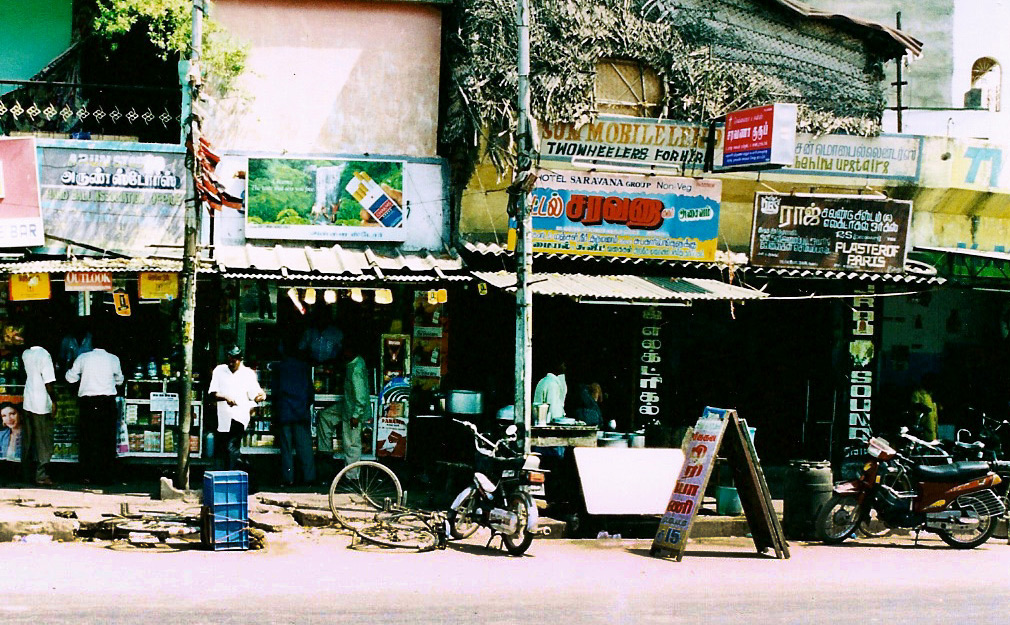 |
| Street Scene - Mumbai, India |
We deleted all identifying patient information and lead information; programmed them to nonpacing mode, when possible, or lowered the outputs to the minimum possible values; turned off all sensing and therapies for ventricular tachycardia (VT) and ventricular fibrillation (VF); and deactivated all ICD alerts (auditory and vibratory). When a sufficient number of devices were collected, they were transported to India in batches. Transport was most often done by physicians (or friends and family members of physicians) who were traveling from the United States. The devices were placed in checked-in baggage in a clear plastic bag, and 2 letters were placed in prominent view. The first letter was signed by the donating physician, stating that the devices were of no commercial value and that they were being donated for reuse in patients who could not afford such devices. The second letter was signed by the Chief Executive Officer of Holy Family Hospital, stating that the hospital was expecting the devices for donation to such patients. Contact information for all physicians was provided in the letters.
Attempts at sending explanted devices by courier or mail proved difficult; without precedent, it was simply not possible to describe the purpose and nature of the shipment to shipping authorities or to insure the contents. We finally resorted to carrying the devices during travel to India in our personal baggage, as described. Some difficulties (requiring lengthy explanations) were encountered during baggage screening and, especially, at Customs in Mumbai.
Device Resterilization Protocol in IndiaThe devices ultimately functioned well, but social and societal limitations caused six of 81 patients to be lost to follow-up. No device infections occurred and three patients even received three such devices over their lifetime.
Once received, the ICDs were removed from their bags and rinsed under running water. We cleaned the headers (lead ports) with pipe cleaners and inspected the seams and body for residual biological debris. We immersed the ICDs in hydrogen peroxide for 10 minutes and then in povidone-iodine for 2 minutes. They were then rinsed with running water for 2 minutes and dried with an air blower. Finally, we double-packaged the devices and sealed them with special indicator-marked paper for ethylene oxide gas sterilization in an automatic ethylene oxide machine (certified by Pest Control of India, Mumbai) at 38 °C. The protocol included 4 hours of ethylene oxide gas exposure followed by 6 hours of aeration, after which inspection confirmed that the package indicator label had changed from brown to lime green. The resterilized ICDs were aerated for at least 12 hours in an open, dry space.
Appropriate shocks were delivered in 42% of patients. Antitachycardia pacing was delivered for ventricular tachycardia (VT) in 12.3% of patients. In total, 60.4% of the devices delivered appropriate therapy (shocks of antitachycardia pacing) in 54.3% of patients. In total, 22 patients received a second device and three patients received a third device after the initial ICD reached the elective replacement voltage. The average time before replacing a resterilized device was approximately 3.5 years.
As the authors noted, in the United States "pacemakers and ICDs are currently labeled as single use devices, and the U.S. Food and Drug Administration specifically prohibits reuse, referring to it as “an objectionable practice." The device manufacturers do not condone reuse and their warranty periods do not include it. Any complications associated with such off-label use could be grounds for legal action."
And yet, lives (and money) were saved, albeit not in the United States.
But this did not stop the critics. In the accompanying editorial, Drs Paul Farmer and Gene Bukhman of the Harvard Medical School, suggested that the authors' efforts failed the quality test, reminding us that "Historians of medicine have shown that the gratitude of patients and their families, although not to be dismissed, is not always a reliable marker of high-quality medical care."
What the....?
Certainly such a practice is controversial, but in a world with such overwhelming medical waste that literally tons of perfectly re-useable medical equipment are discarded each month in America's hospitals, I feel these authors should be congratulated for their efforts to humanely break the status quo and forcing us to consider the obvious ethical implications of discarding life-saving, exceedingly expensive medical devices (and similar medical equipment) that could be used to help others less fortunate.
In our current global health care cost crisis, we need more innovation in the area medical areas like this, not less.
-Wes
References:
Pavri BB, Lokhandwala Y, Julkarni GV, Shah M, Kantharia BK, Mascarenhas D. ReUse of Explanted, Resterilized Implantable Cardioverter-Defibrillators: A Cohort Study. Ann of Intern Med 16 October 2012;157(8):542-54.
Farmer P, Buckman G. Reuse of medical devices and global health equality. Ann Intern Med 2012; 157:591-593.
No comments:
Post a Comment